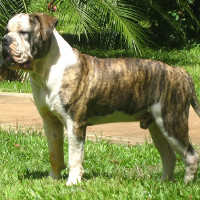Considered by some to be only a localized strain of the original Fila Brasileiro and seen by its breeders as a separate breed, the robust Cabeçudo has existed since the 16th century as a working dog in the rural areas of Brazil's Minais Gerais state. Although developed from the same ancestral stock as the popular Fila Brasileiro, the Cabeçudo Cattledog has remained relatively unchanged for centuries, unlike the modern Brazilian Mastiff, which has been enriched with blood from other breeds in recent history. The Cabeçudo was created as a superb property guardian, great game hunter, breeder and protector, combining the best working traits of its ancestors, while being much better adapted and suited to the terrain and climate of its native region. Simple, robust and versatile, Fila Onceiro was an ideal companion for the farmers of Minais Gerais, who needed a dog with uncompromising loyalty to their owner's family and strong guarding instincts, yet powerful and tenacious enough to hunt jaguars. drive, guard and control their boisterous livestock. The breed was also used as a retiever slave in the past, as they were able to track and hold escaped humans without killing them.
Although rare and little-known, this old Molosse still exists and can be found protecting farms and driving cattle in Brazil, where its breeders and enthusiasts consider it the "real deal", while ignoring the modern incarnation of the Fila Brasileiro as a new "mongrel" created for show rings. On the other hand, the majority of people don't even recognize the differences between these two Brazilian dogges, let alone the Cabeçudo Boiadeiro das Minas Gerais as a distinct breed. Although superficially similar in physical appearance, the Cabecudo Cattledog differs from its cousin, the Fila Brasileiro in head size, height and overall mass. However, the biggest difference between them lies in their resilience and, above all, their temperament, since the famous "ojeriza" trait is much less evident in the Cabeçudo population, which is more docile overall than the majority of Filas. Although it can make a very capable guard dog, the Cao Boiadero is first and foremost an old farm dog, used as a companion for fruit and coffee pickers, as well as for following breeders, who often travel great distances on horseback with the help of 3 or 4 of these dogs, bringing them back from the pastures to the farms.
The Brazilian Cabeçudo Boiadeiro moves easily, but is a little lethargic when relaxed, yet remarkably quick to react with force and speed when needed. He is not generally aggressive to dogs, although males will engage in combat when provoked. This is a powerful, well-boned Molossus, with reasonably loose skin and a deep chest. The head is fairly broad, with a strong muzzle, powerful jaws and a dry mouth. The coat is short and flat, most often seen in shades of yellow, wheaten and fawn, with or without a black mask on the face, but slightly brindle dogs also exist, as do examples with white markings on the feet and chest. The average height is around 63.5 centimeters. |







 English (United Kingdom)
English (United Kingdom)